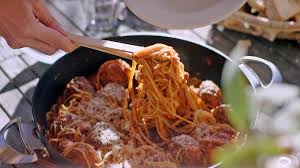Italy: How to cook the perfect pasta

Rome: Dinner parties – you either thrive on them or you don’t. Regardless of your status as a seasoned host or first-timer, pasta is an efficient way of catering to a large group of people and pleasing them all equally. After all, who doesn’t love pasta?
Marco Sangiorgi is all too familiar with cooking pasta for large volumes of people as the head chef at Oakleigh restaurant, Just Italy.
He has a few suggestions for crowd-pleasing pasta sauces that are simple and delicious. These can all be made and served on the night, while your guests arrive and chat over a glass of wine.
“I enjoy cooking aglio e olio – oil and garlic pasta – especially late at night when everyone is full of wine and craving something.”
Amatriciana, a traditional dish from the town of Amatrice, Italy, tops his list. It’s made using guanciale, tomato and pecorino from the area. “It’s classic. Italian at its best,” says Sangiorgi.
“Carbonara – with egg yolk, pancetta, black pepper and parmesan is good [and] I enjoy cooking aglio e olio – oil and garlic pasta especially late at night when everyone is full of wine and craving something. I also add some chilli to mine.”
Let these babies blip on the stove all afternoon and serve with freshly-cooked pasta.
Taking a low and slow route, host of Cook Like an Italian, Silvia Collaca, asks “what could be more iconic than spaghetti and meatballs?” It’s her trusted go-to when cooking pasta for a group, using her nonna’s polpette recipe – made with bread soaked in milk, pecorino, and ricotta to ensure they aren’t crumbly or dry.
The real beauty of this dish is you can prepare your sauce ahead of time, put it to the side and all that’s left to do is cook the pasta fresh when (or just before) your guests arrive.
Orecchiette is an ear-shaped pasta and it’s served here with pangrattato, which are essentially fancy breadcrumbs to give it a nice crunch.
How much is too much? “Per portion of pasta, I use one to two medium-sized scoops of sauce,” Sangiorgi says. “A trick is to use some of the water that you boil the pasta in for extra flavour.”
Colloca says “there is nothing that irritates an Italian more than seeing a bowl of cooked pasta with just a few spoons of sauce on top. This is not how we do it. … Make sure each piece of pasta is covered with sauce”
Chef and cookbook author Rosa Mitchell agrees. “Keep it simple and remember you’re having pasta with sauce not sauce with pasta!”
Also add plenty of parmesan. But Sangiorgi warns not to add it to seafood pastas as, “that’s not acceptable.” Regular taste tests are the best way to check on pasta done-ness.
Fresh pasta is set to impress the guests, but dried pasta with an epic sauce will do just as well. Per person, Sangiorgi recommends a serving of 140 – 180 grams for fresh pasta and about 90 – 120 grams will do for dried pasta.
Cooking pasta al dente is key, and really depends on its shape and thickness. Boiling the pasta is your time to stick by the stove, as you don’t want it to be mushy.
“Never add oil to your pasta water, just salt,” says Mitchell. “Be guided by the time on the packet, but it’s always important to taste yourself.” Colloca warns the pasta will keep cooking when added to sauce, so you want it a bit under-done. “Be guided by the time on the packet, but it’s always important to taste yourself.”
Variants like water temperature and salt level can change how rapidly pasta is cooked but it’s essential to add adequate salt to enhance pasta flavour. When it comes to hosting, Mitchell takes a different approach over serving up a plate of quickly-blanched pasta, guest by guest.
“I’d say if I was having a pasta party I’d only make baked pastas like cannelloni,” she says. The ideal dish for those who have their hands full hosting and want to keep things simple.





